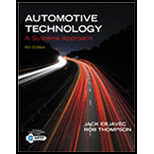
Although computers receive different information from a variety of sensors, the decisions for shifting are actually based on more than the inputs. What are they based on?
The decisions shift or not to shift in the automatic transmission.
Answer to Problem 1RQ
The decisions to shift or not to shift in automatic transmission are based on the shift schedule and logic.
Explanation of Solution
Transmission control module (TCM) is designed or programmed in such a way that it receives signals from sensors, engine related or driver-controlled sensors to control the shift timing, torque converter clutch and shift feel. But the decisions to shift or not to shift is based on the shift schedule and logic. In shift schedule composed of shift points and are precisely selected based on the signals from appropriate sensors. Shift schedule logic select the appropriate gear. Other inputs TCM used to control shift speed are:
Throttle position.
Manifold absolute pressure.
Mass airflow.
Intake air temperature.
Barometric pressure.
Engine coolant temperature.
Crank shaft position.
Want to see more full solutions like this?
Chapter 42 Solutions
Automotive Technology: A Systems Approach - With Manual and Access
- Mark the good definitionarrow_forwardExplore the use of gyroscopic and accelerometer-based mouse control in devices like air mice and gaming controllers.arrow_forwardYou’re testing a system that involves a fan, water pump, and compressor. The components are turned ON in sequence and sensor readings are taken, as per a written protocol that you’re following. The system is running as expected after the fan and water pump are turned ON. However, when you turn ON the compressor, it runs for about thirty seconds then stops, consistently. Swapping out the compressor for a different one seems to solve the problem. What could have been the issue with the bad compressor?arrow_forward
- Explain the mechanism of an autopilot? how does autopilot functions work?arrow_forwardInertial sensors for aerial robotics typically come in the form of an Inertial Measurement Unit (IMU) which usually consists of (a) accelerometers (b) magnetometers (c) gyroscopesarrow_forwardsolve in peaperarrow_forward
- Please help me with the Mechanical Design question in the image below. Thank you so much!!arrow_forwardWhat is the difference between static lateral stability and lateral stability? I see textbooks differentiate between the two but I don’t understand the differencearrow_forwardConventional float actuated device is used as a level measurement sensor, which consist of pulley and a pointer which move over a graduated scale. Let say you are asked to develop a controller-based float actuated system having a sensor for level measurement or may be more than one sensor is required for accurate level measurement, which sensor will you use and why? Draw the whole schematic showing the position of the sensor or sensors. Will pulley be part of your new digital system, if yes justify your answer, if no, then how you will develop a system without using pulley.arrow_forward
 Automotive Technology: A Systems Approach (MindTa...Mechanical EngineeringISBN:9781133612315Author:Jack Erjavec, Rob ThompsonPublisher:Cengage Learning
Automotive Technology: A Systems Approach (MindTa...Mechanical EngineeringISBN:9781133612315Author:Jack Erjavec, Rob ThompsonPublisher:Cengage Learning
